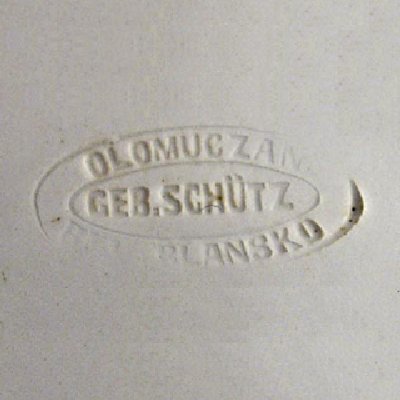
Image 020401-01-01
Used between 1854 and 1870, "Olomuczan" above "Geb. Schütz" above "bei Blansko".
In the year 1852 Karl Schütz (*1789, †1872), owner of a local paper mill, purchased the pottery in Olomuczan which had been originally established by Peter Eugen Selb and Carl Gustav Lenk in 1849. Schütz expanded this into a factory and in 1859 transferred management to the freshly established trading company owned by his sons, chemist Ludwig Richard Schütz (*1828-APR-25 in Hinterwasser, † 1907 in Cilli) and Dr.jur.utr. Arnold Schütz (*1832-JUL-18 in Hinterwasser). The latter was often claimed to have been a lawyer, which he was not. He had acquired a doctorate in both civil and church law, hence juris utriusque, and was what Germans call an Advokat, which in English terminology was more like a barrister or solicitor.
Telegraph address for this business was from then on Schütz Blansko. At first business concentrated on the production of brown kitchenware and earthenware decorated in the common rural painting style, so-called "Bauernmalerei", but soon moved on to artistically demanding and representative majolica, including plates, figures, vases, and finally also fire bricks and tiled stoves. Their cobalt blue decorations and glazes were also very successful.
The company quite early secured access to its own resources, like white clay, feldspar and coal. One subsidiary created for this specific job was the clay pit in Flöhau (Blšany), another was the subsidiary in Liboje near Cilli, founded in 1870. Also between 1870/1871, the Handelsgesellschaft founded a further factory in Pletrowitsch (Petrovče) near Cilli as a clay deposit of high quality had been discovered there, allowing the brothers to shift towards finer products. It was during this time that it was decided to adapt a name more appropriate for a company group which including mining and production.
The Schütz factories over time won an impressive amount of prizes and medals for their items, here only an excerpt: Medal of Merit in Vienna (1873). Gold medal awards in Munich (1876), Nürnberg (1878), Adelaide (1887), Sidney (1888), Graz (1890), Vienna (1898). Silver medal award Paris (1878).
Nonetheless both Schütz brothers developed different views regarding certain aspects of the businesses they were involved in, also each of them had multiple children; this lead to a situation in which it would be better to divide business into different segments, even if they would still be working together closely.
Not only did they keep up a main name for all included operations, they still supplied each other with raw materials and shared the dedicated art department (responsible for item and pattern designs, located upon Beatrixgasse in Vienna) but also shared the large sample room at "Wien III, rechte Bahngasse 8", which also included a small print shop.
Even if the split officially took place in 1890 there are various indications that Ludwig Richard Schütz had already operated independently before that, under his own name. The earliest hint could probably be a newspaper clipping from August 22nd 1876 which refers to the "Thonwaarenfabrik L.R. Schütz aus Liboje". Then there is the fact that the licensing contract with Kosch (see Liboje) was explicitly granted to Ludwig R. Schütz alone, not the Handelsgesellschaft. Finally, we have the mentioning of the present he made towards the Österreichisches Museum in 1883. Such a present would normally have come from the Handelsgesellschaft as it would have represented the skill and expertise of the whole business, not that of L.R. Schütz alone.
Whatever reason it have may been, both parties continued on their own from 1890 onward, with Arnold Schütz keeping the original name and business in Olomuczan while Ludwig Richard Schütz continued in Pletrowitsch, Liboje and Flöhau. It should be kept in mind that Arnold Schütz kept the original name for the Olomuczan facility; what seems to have confused people even more is the fact that the whole group of factories and subsidiaries actually continued to operate under the business handle of Steingut-, Majolika-, Fliesen-, Ofen- und Schamotte-Fabriken Gebrüder Schütz.
In 1898, after roughly seven years of running the Olomuczan facilities on his own, Arnold handed over the factory to his son-in-law Wilhelm Julinek who was soon in need of assistance. It should be mentioned here that some sources indicate that the business in Olomuczan was in 1904 actually sold to Oskar Basch, while other sources do not mention this at all; it should also be mentioned that Google's Handbuch der Keramikindustrie scan is very unreliable as their bad OCR transformed him into Oscar Bauch.
Anyway, fact is that the 1906 edition of the Handbuch der Keramikindustrie clearly states that the original company name was still used and that the proprietors at that time were Oskar Basch and Emil Mandl together with Franz Julinek and Wilhelm 'Willy' Julinek. A few people may be perhaps used to the more common name of Jelinek, however I was able to verify this case through the Verzeichnis der Mitglieder der Mährischen Museumsgesellschaft from 1906 which in clear print stated Willy Julinek, Thonwarenfabrikant, Olumuczan. Czechs translatomaniacs are known to have also created the names Vilém Julink and Viléma Julinka from this.
The same Handbuch der Keramikindustrie also mentions that the whole business had around 200 workers at that time, was specialized on majolica and earthenware products (including planters and tiles) and was involved in clay mining operations in Blanz (Blansko), Gross-Opatowitz/Briesen (Velké Opatovice/Březina), Olomuczan (Olomučany) and Ruditz (Rudice). All involved operations with own clay mills used water power when possible, backed up by either steam- or combustion engines.
Under Basch's management, the factory stopped producing fine ceramics and started to concentrate only on fireclay goods and clay mining; in the end the complete Olomuczan-related business merged into the Keramična Industrija d.d. Zagreb in 1922.

Image 020401-01-01
Used between 1854 and 1870, "Olomuczan" above "Geb. Schütz" above "bei Blansko".
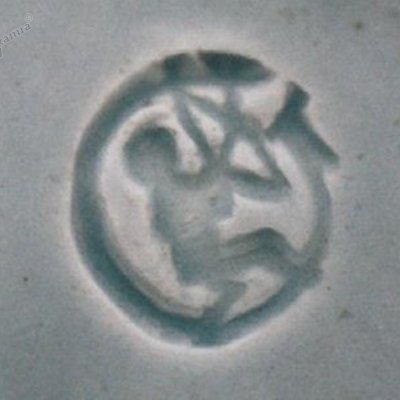
Image 020401-01/02-02
Used between 1854 and 1906. Perfect example of the export mark, a kneeling archer (German: "Bogenschütze") in a capital "G".

Image 020401-01/02-03
Used between 1854 and 1906, a faintly impressed version.
(Picture by Nancy Harris)
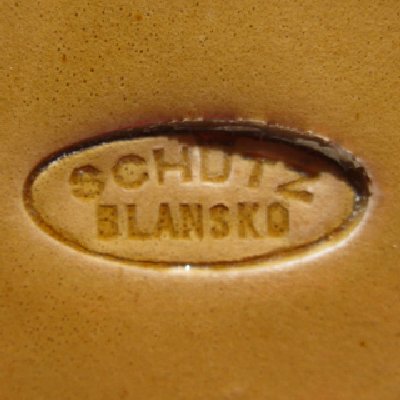
Image 020401-02-01
Used from 1890 onward, oval containing "Schütz" above "Blansko".
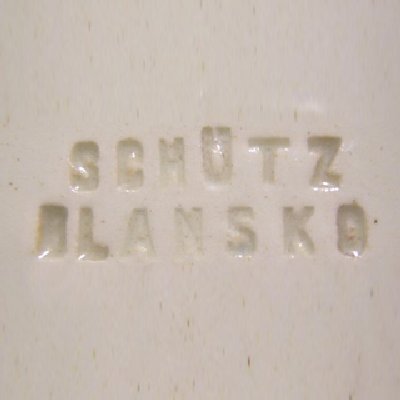
Image 020401-02-02
Used from 1890 onward, the marking simply states "Schütz" above "Blansko".
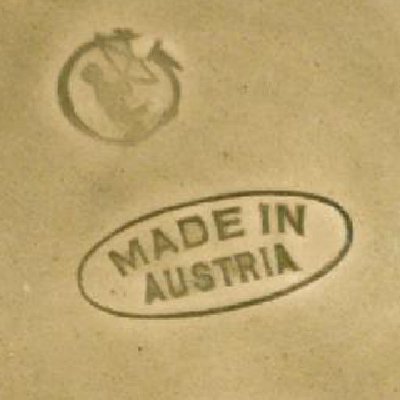
Image 020401-02-03
Used around 1897 and 1906, "Made in Austria" included after the country of origin became important on export goods.
(Picture by Brian Williams)
© 2004-2025 C.S.Marshall, all rights reserved